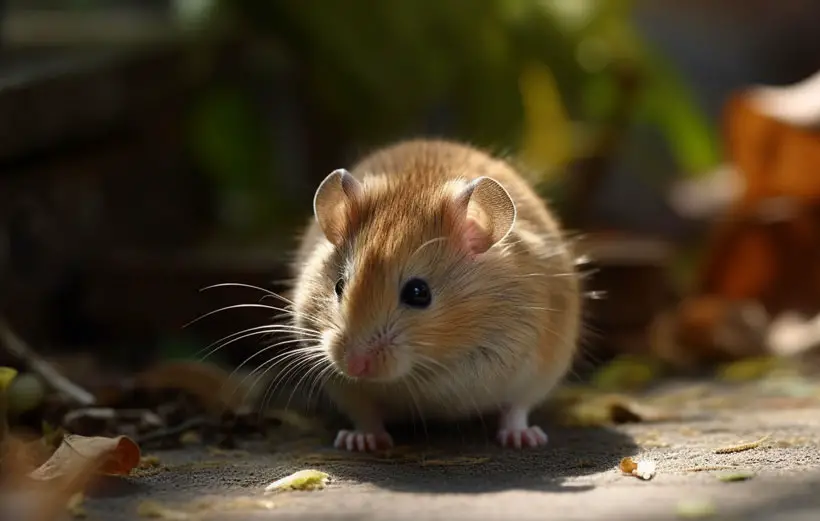Hamster Behavior: Understanding Your Pet’s Actions and Body Language
Like all other animals hamsters have their own behavioral pattern. So how would you tell what they are feeling? Well, that’s easy “Communication”. But wait, hamsters don’t talk, so how would you know? Well, that’s easy.
Because the hamsters will tell you themselves. Hard to believe right? But it is true. From scent messages to high-pitched sounds that humans generally can’t hear, these munchkins use various methods to communicate with you and other animals.
As a hamster parent, it’s crucial to understand their behaviors to have a strong bond and ensure they live a healthy and happy life. So, in this article, we’ll discuss the different behavioral traits of your pet!
Hamster Behavior: The Three Core Hamster Behavior

Below we’ll discuss the three core behaviors to determine your hamster’s mood on a daily basis.
1. Normal Hamster Behavior
Hamsters in their course of life showcase some normal behavioral patterns. Here are some key aspects of hamsters’ behavior:
Nocturnal
Hamsters are nocturnal animals. This means they are most active at night and mostly sleep during the day. You should keep this in mind while planning the rodent’s daily routine. It would be best to provide them with a quiet and dark place to sleep during the day.
2. Territorial
Another aspect of their behavior is their possessiveness. Hamsters are territorial animals and can become aggressive towards other hamsters or even their owners if they feel threatened or their territory is invaded. Hence, it’s important to provide them with enough space and resources, such as food and water, to avoid conflicts.
Accordingly, there are other territorial behavioral aspects the hamster possesses, such as
Burrowing
Hamsters are natural burrowers. They really enjoy a nice day of digging and creating tunnels. You should Provide them with a deep layer of bedding and hiding places in their cage. This can help them satisfy their playful nature.

Chewing
Hamsters have constantly growing teeth. Which means they need to chew on objects to keep them trimmed. Giving them chew toys can help prevent dental problems. Of course, the chew toy must be made of safe material.
Social Behavior
Contrary to popular belief, not all hamsters are social animals. Some species of hamsters, such as Syrian hamsters, are solitary animals and prefer to live alone. There are others, such as dwarf hamsters, who want to live in pairs or small groups.
These Hamsters regularly groom themselves and others in their social group if they feel comfortable in their surroundings. You need to know more about your hamster’s social pattern. Otherwise, an in-cage fight may occur anytime.
Active and Playful
Hamsters are naturally active and playful. These animals spent most of their time running on wheels, playing with toys, and exploring their environment. This is a very normal behavior of them.
Hibernation
In the wild, hamsters hibernate during the winter. Pet hamsters may still hibernate if their environment is too cold.
3. Happy Hamster Behavior

A happy hamster will display a range of behaviors that show they are content and comfortable in their environment. Here is a table showcasing that:
| Behavior | Description |
| Active and alert | A happy hamster is active and alert |
| They explore their environment and move around their cage | |
| They are curious and interested in their surroundings | |
| Playful | Happy hamsters enjoy playing with toys |
| They interact with their owners | |
| They may engage in activities such as running on a wheel, climbing, and digging | |
| Comfortable with handling | When they are happy, hamsters become comfortable with being handled |
| They will not bite or nibble excessively | |
| They may even enjoy being picked up and held by their owner | |
| Hamsters often yawn and stretch when they feel comfortable in their environment | |
| Good appetite | A happy hamster has a good appetite |
| It will eat regularly throughout the day | |
| It may also show excitement when food is presented to it | |
| Clean and groomed | Hamsters are naturally clean animals, and happy hamsters will groom themselves regularly |
| They will also keep their cage clean by using a designated area as a bathroom | |
| Calm and relaxed | Happy hamsters are generally calm and relaxed |
| They may even fall asleep in their owner’s hand or lap |

Other Behaviour
Apart from that your hamster may showcase some other behaviors. Here I will show you what they mean or if you should do something about it:
| Behavior | Meaning | Possible Causes/Actions |
| Watching with erect ears | Curious and calm | Normal behavior |
| Stretching | Relaxed and feeling good | Normal behavior |
| Ears forward, cheeks puffed, mouth open | Frightened and stressed | Remove stressors, Try to provide toys |
| Emptying cheek pouches quickly | Insecure and likely to flee/hide | Provide a safe and secure environment |
| Standing on hind legs with dukes up | Threatened and may become aggressive | Backoff and give space |
| Startled when approached | Insecure and unsure of surroundings | Move slowly and calmly |
| Ears laid back with narrowed eyes | Suspicious and sense something is wrong | Observe and remove potential stressors |
| Lying on back with incisors showing | Frightened and threatened | Leave alone and give space |
| Creeping slowly along cage sides | Unsure of surroundings or trying to orient themselves | Try to give it a natural environment |
| Freezing in place | Playing dead to avoid danger or threat | Try not to approach too much. Bond gradually. |
| Chattering teeth | Fearful and ready for aggression | Back off and give space |
| Shy and always hiding | Stressed by loud noises, aggression, or over-eager children | Provide a quiet and secure environment |
| Unresponsive | May have illness or injury | Observe and assess the situation, seek veterinary care as needed |
| Lazy or lethargic | May be sick or under the weather | Observe and assess the situation, seek veterinary care as needed |
| Biting/nipping | Frightened and defensive | Build trust and respect with the hamster |
| Hamsters fighting | Displaying dominance or defending territory | Separate and provide individual housing or reintroduce slowly |
| Repeating behavior | May indicate mental distress | Provide larger cage and enrichment toys, seek veterinary care as needed |
| Shaking | May be cold, stressed, old, trying to dry off, or have an illness | Assess the situation and provide appropriate care or support |
Signs of A Stressed Hamster
Hamsters are sensitive animals. And so, changes to their environment or routine can cause them stress. Some common factors are improper housing, lack of exercise, insufficient diet, loneliness, illness, and excessive noise or light.
A stressed hamster becomes weak day by day and eventually falls to their grave. Here are some signs or behaviors they exhibit when they are stressed:

Aggressive Conduct
Stressed hamsters are more likely to act aggressively. Therefore, it is essential to offer them space. Avoid touching them with your fingertips. They have a tendency to bite when agitated.
Hair Loss/Fur Changes
Hamsters that are under stress may overgroom or yank out their fur. If you observe bald spots or thinning hair, your pet is undoubtedly agitated. In addition, tension may lead their fur to grow sparser, oilier, or messy.
Digging
Digging excessively or not at all, rolling, rubbing, licking, or running in circles constitute all indicators of an agitated hamster.

Cage Biting
Hamsters can occasionally bite their enclosure. If your companion does this once per week, there is no cause for alarm. However, doing so daily is an indication of difficulty.
High-Energy Conduct
Hamsters under stress may exhibit hyperactivity and restlessness. When they are anxious, they frequently repeat the same circuit around their cage. On occasion, they spend extended periods of time on their exercise apparatus.
Vocalizing
Typically, hamsters are very silent. However, they may produce greater disturbances than usual when stressed. When they do so, they attempt to convey that they are anxious, frightened, or distressed.
Hamster Behavior Before Dying

Hamster ranks among the animals that have the least lifespan. That is to say, some behavior might warn you that your pet buddy is dying:
- Loss of appetite
- Reduced activity levels
- Huddling in one spot
- Difficulty breathing
- Decreased responsiveness
- Weight loss
- Dehydration
- A hunched posture
Conclusion
Your hamster’s behavior depends on many factors. But in general, Hamsters are a great pet to have. If you know clearly how they function and which act they display, you can give this little rodent a happy and healthy life.
By paying attention to their body language, vocalizations, and other subtle signs, you can tell when your hamster is content or stressed. If your hamster is stressed, you can take appropriate action. And if you are unsure which hamster behavior means what, consult with your vet. He will tell you what you should do. Remember, a happy pet is a healthy pet.




